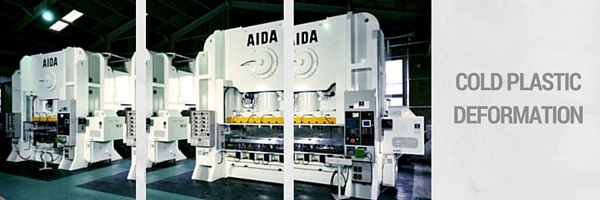
Cold plastic deformation – The stainless steels (in particular the austenitic ones) have an obvious attitude to be cold formed. Also, these undergo a phenomenon of strain hardening that is, the raising of mechanical properties as the ultimate tensile strength, yield strength and surface hardness.
Molding process: the static pressure or dynamic actions.
The molding process is a machining of press or dynamic actions (hot or cold) means for the plastic deformation. The latter put on material to presses or trip hammer. This pressure aims to force the material to fill the recess between two metal matrices (usually a mold). In the case of metallic materials get started to solid elements as rods, billets, bars or disk.
The deep drawing: how does it work?
The deep drawing is a sheet metal forming process in which a sheet metal blank is radially drawn into a forming die by the mechanical action of a punch. It is thus a shape transformation process with material retention. The process is considered “deep” drawing when the depth of the drawn part exceeds its diameter. The deep drawing with the press keeping the sheet metal edge by a blank-holder “b”. And later the pressure with a stamp “c”, until it is at the bottom of the mold “d”.
The advantage of this blank-holder are:
- prevent that the sheet is pulled inside the mold, before it has time to assume the final shape
- prevent folds at the edges.
The mold, the stamp and the blank-holder together are called “mold”. The molding process using:
- mechanical presses (when is needed an high speed production and small/medium depth of stamping)
- hydraulic presses (when the depth of stamping are considerable)
Work hardening: what are the effects on the material properties?
Work hardening, also known as strain hardening or cold working, is the strengthening of a metal by plastic deformation. It may be desirable or undesirable depending on the context:
- mechanical properties:
- increase the hardness and tensile strength
- decrease the ductility (as the lengthening and the necking)
- decrease the static and dynamic tenacity end (as the resistance)
2. physical and chemical properties:
- increase the coercitive field strength, the thermal expansion coefficient and the compressibility.
- decrease the intensity, the electric conductivity, the magnetic permeability and the corrosion resistance.
Cold plastic deformation.
Find our stainless steel items on Inoxmare web shop.
Click here


